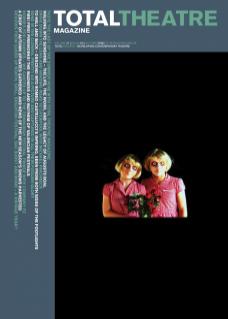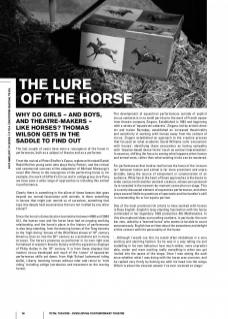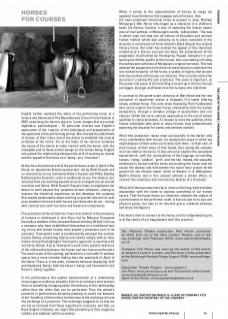The last couple of years have seen a resurgence of the horse in performance, both as a subject of theatre and as a performer.
From the revival of Peter Shaffer’s Equus, replete with naked Daniel Radcliffe (the young actor who plays Harry Potter), and the critical and commercial success of the adaptation of Michael Morpurgo’s novel War Horse, to the resurgence of the performing horse in, for example, the work of Gifford’s Circus and in voltige group Jive Pony, we have seen a wide range of approaches to including this animal in performance.
Clearly there is something in the allure of these beasts that goes beyond our normal fascination with animals. Is there something in horses that might just remind us of ourselves, something that taps into deeply held associations that are not rivalled by any other animal?
Since the horse’s domestication (sometime between 4000 and 2000 BC), the human race and the horse have had an ongoing working relationship, and the horse’s place in the history of performance is also long-standing, from the dancing horses of the Tang dynasty to the ‘high-diving’ horses of the Wild West shows of 19th century America, then on into the 20 th century as a prominent act in many circuses. The horse’s presence as performer in its own right was formalised in western theatre history with the equestrian displays of Philip Astley in the 18th century. It is from these displays that modern circus developed and much of the ‘canon’ of equestrian performance skills set down; from High School (advanced riding skills), Liberty (working horses without rider and reins) to ‘trick riding’ including voltige (acrobatics and movement on the moving horse).
The development of equestrian performances outside of explicit circus contexts is in no small part due to the work of French equestrian theatre company Zingaro. Established in 1984 and beginning with a series of ‘equestrian cabarets’, Zingaro, led by artistic director and trainer Bartabas, established an increased theatricality and sensitivity in working with horses away from the context of circus. Zingaro established an approach to the creative process that focused on what academic David Williams calls ‘encounters with horses’, identifying these encounters as having sympathy with ‘impulse-based dance forms’ (such as contact improvisation). In essence, shifting the focus to seeing what happens when human and animal meet, rather than what existing tricks can be mastered.
For performances that involve real horses the focus of the ‘encounter’ between human and animal is far more prominent and unpredictable, being the source of amazement or consternation of an audience. What lies at the heart of these approaches is the desire to make contact with another sentient creature, whose own personality is revealed in the moment-by-moment connection on stage. This is a rarely discussed element of equestrian performance, and often plays second fiddle to questions of spectacle and the handler’s skill in commanding his or her equine partner.
One of the most prominent UK artists to have worked with horses is Rose English. English’s long-standing fascination with the horse culminated in her legendary 1992 production My Mathematics. In this she explored ideas surrounding numbers, in particular the number zero, aided by a ‘learned horse’ who seems to be able to count autonomously. English has written about the sensations and delight of this contact with the personality of the horse:
‘…Although I would cue him, he would often misbehave in a very exciting and alarming fashion. So he was in a way telling me and modelling in his own behaviour how much wilder, more unpredictable, vaster and more exciting really everything is when you get invited into the space of the stage. Once I was asking the audience whether what I was doing with the horse was coercion, and he replied very firmly by butting me with his head into the wings. Which is about the clearest answer I’ve ever received on stage.’
English further explored the allure of the performing horse at a lecture she delivered at The Roundhouse’s Circus Fronts Festival in 2007, examining the horse’s place in ‘iconic images that are actual, legendary, psychological...’ Of particular interest was English’s exploration of the ‘caprice’ of the techniques and presentation of the spectacle of the performing animal. She charted the adornment of horses, of their riders and of the desire to embellish the natural activities of the horse. Yet at the heart of her lecture remained the sense of the desire to make contact with the horse, with the intangible pull of these animal beings on the human being. English articulated the relationship between the skill of working an animal and the appeal of the horse as a ‘being’, as a ‘character’.
At the more mainstream end of the performance scale is Spirit of the Horse, an ‘equestrian theatre spectacular’ led by Nikki Fossett and co-directed by circus luminaries Robert Fossett and Philip Gandey. Reflecting the Fossetts’ roots in traditional circus, the show is constructed from pre-existing equestrian acts arranged into an overall narrative and theme. Nikki Fossett though is keen to emphasise her desire to work beyond this ‘potential artistic limitation’, aiming to improve the theatrical experience as she develops the company. She speaks passionately about wanting to provide interest for audience members that work with horses and those who do not – mixing skill-centred acts with narrative and theatrical components.
This activation of the animal into ‘more-than animal’ in the presence of humans is evidenced in Jive Pony, led by Rebecca Townsend (formally a member of the Jerwood Award-winning Gifford’s Circus, a company who have established themselves as a traditional touring circus and whose horses have played a prominent part in its success). Townsend’s work is predominantly amongst the summer County Shows, presenting Liberty and Liberty voltige, with an informative strand that highlights Townsend’s approach to working with her horse, Ronan. Key to Townsend’s work is the explicit reference of the relationship between the human and non-human performers. The small scale of this pairing, performed in a naturally-lit outdoor space, has a more intimate feeling than the spectacle of Spirit of the Horse. There is, in the work, a balance between displaying ‘skill’ and displaying ‘being’; both the horse’s ‘being’ and Townsend’s and Ronan’s ‘being’ together.
In the performance this explicit demonstration of a relationship encourages an audience empathy. Even in an outdoors environment, there is something intriguing about the delicacy of the relationship, rather than the tricks that can be performed. Thus the animal’s presence in performance becomes pleasing to watch not because of the ‘handling’ of that animal, but because of the exchange of trust, the exchange of a presence. This exchange suggests to us that we are not so removed from these magnificent creatures, and that, as Rose English intimates, we might find something of their elegance, nobility and wildness within ourselves.
When it comes to the representation of horses on stage (as opposed to performance that engages actual horses), then the most prominent theatrical horse at present is Joey, Michael Morpurgo’s War Horse, who began as a character in a children’s book; his literary function a way of exploring the human experience of war without, in Morpurgo’s words, ‘taking sides’. The way in which Joey can step into all manner of situations and uncover human frailties whilst also allowing us to place ourselves in the situation is reminiscent of Anne Sewell’s Black Beauty, the original literary horse. But what has marked the appeal of this theatrical rendering of a literary success has been the achievement of the puppeteers (led/trained by Handspring Puppet Company) in presenting the lifelike quality of the horses, thus succeeding in finding the pathos and catharsis of Morpurgo’s original narrative. This has allowed the puppeteers to find and recreate what we could term the ‘non-human humanity’ of the horse, a quality of dignity that anyone who has worked with horses can attest to. This is reinforced by the success in creating life-size creatures. The scale is important, as the power and grace of the real thing is bound up in the fact horses are bigger, stronger and faster than the humans who ride them.
In contrast to the grand-scale catharsis of War Horse and the raw encounter of equestrian shows is Company FZ’s latest offering, simply entitled Horse. This solo show (featuring Flick Ferdinando) sets out to explore the human-horse relationship from the human perspective, through a complex collage of associations and caricatures. Unlike the more common approaches to the use of animal qualities in characterisation, FZ choose to mine the qualities of the human individuals who work or enjoy horses, thus predominantly exploring the situation for comic and emotive content.
What this production raises most successfully is the darker side of our relationship with horses; for example the ways in which we might dispose of them when we’re done with them – of their skin, of their hooves, of their meat, of their heads; thus raising the complexity of our debt to the horse. FZ also set out to explore the sexualised ‘equestrienne’, with the connotations of the language surrounding horses: ‘riding’, ‘stallion’, ‘girth’, and the like. Indeed, the sexuality evidenced in horses and the terms surrounding the horse (and his cousin the donkey and half-brother the mule) have proven fertile ground for the theatre-maker (think of Bottom in A Midsummer Night’s Dream), and in this context achieve a similar effect, to uncover the conscious and unconscious desires of a character.
What all of these productions do is draw on the long-held and deep association with the horse to express something of our human nature. That the horse draws our attention, whether the subject of a performance or the performer itself, is due not just to its size and physical power, but also to its inherent grace, subdued wildness and sharp intelligence.
This desire then to connect to the horse, and its independent spirit, is at the centre of our beguilement with this creature.
The National Theatre production War Horse continues its West End run at the New London Theatre, and is taking bookings until February 2010: www.newlondontheatre. co.uk
Company FZ’s Horse was seen by the author of this article at Jackson’s Lane in London, and the show will be presented at the Edinburgh Festival Fringe August 2009: www.edfringe. com
Equestrian Theatre Zingaro : www.zingaro.fr
Jive Pony: www.jive-pony.co.uk and Townsend’s other strand: www.barebackburlesque.co.uk
Spirit of the Horse: www.equestriantheatre.co.uk


